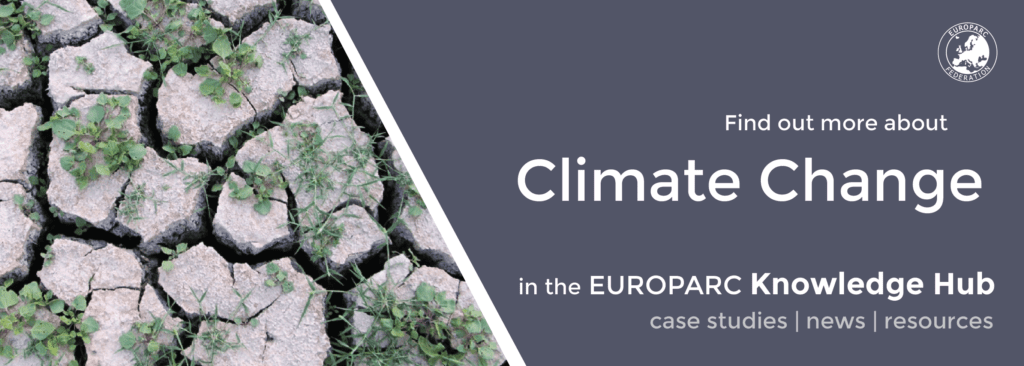Are you EUROPARC’s new Youth Representative?
EUROPARC is committed to providing a place and opportunities for young people within our organisation. That is why we are now launching a call for a Youth Representative to join the EUROPARC Council.
Are you:
- Between 18 and 30 years old?
- Active in a Protected Area that is a member of the EUROPARC Federation?
- Supporting youth engagement in Protected Areas?
- Fluent in English?
Or have you attended EUROPARC international events and initiatives for Youth and Junior Rangers? Then we are looking for you!
To honour the commitments made in the EUROPARC Youth Manifesto, but also to adhere to the new EUROPARC Strategy to 2030, we are now seeking ways to better integrate the views of youth in the governance of our organisation and inspire Protected Areas to do the same. The EUROPARC Council has therefore agreed in October 2021 to assign one of the coopted seats available in the council, to a suitable Youth candidate.
Role and Functions
As Youth Representative you will have the same rights, duties and responsibilities – other than voting – as the rest of the Council. Your task will be to bring specific insights to the Council on youth related matters relevant for the work of Protected Areas and provide constructive advice on Council work and Federation strategy and priorities. You will also be able to represent the work of EUROPARC, where appropriate, in exchanging with youth organisations and networks all over Europe. The function will be a chance to connect and communicate with young people from across Europe’s Protected Areas.
Does this sound like something you can do? Or do you know someone who would be the perfect fit? Then apply now!
How to apply
The application process is simple:
- Carefully read the terms of reference.
- Fill out the application form.
- Send the signed application form, together with your CV to Esther Bossink (esther.bossink@europarc.org) until the Friday 17th of December 13:00 PM CET .
If you have any questions, do not hesitate to reach out to Esther Bossink. We look forward to seeing all your applications!
COP26 – We need nature to combat climate change!
Geran de Klerk on Unsplash
From 31.10. to 12.11.2021 50,000 participants, both online and in person, including world leaders from almost 200 countries, politicians, activists, scientists, activists, journalists and representatives of NGOs and businesses gathered to negotiate and discuss global climate action for the short and long term future.
Main outcomes of COP26
The event was not strictly a political one, as many were there to share ideas, solutions, attend cultural events and build partnerships and coalitions. It hosted many empowering announcements, speeches and long negotiations, culminating with the countries agreeing on the Glasgow Climate Pact centred on adaptation, conservation, climate finance and mitigation. Parties concurred to boost their carbon-cutting commitments, phase down fossil fuels and increase aid to loss and damage caused by climate change.
The Paris Agreement rulebook was also finalized, setting out transparency and monitoring plans to keep on track with the 1.5 degrees target.
Glasgow Climate Pact
This final deal was signed by leaders of almost 200 countries. The agreement calls for an accelerated effort “towards the phase-down of unabated coal power and inefficient fossil fuel subsidies”.
We all know that European wealth was built on coal. And if we don’t get rid of coal, European death will also be built on coal
said Frans Timmermans, vice president of the European Commission, who is leading on big portions of the “green agenda” of the EU. The phasing out of coal and fossil fuels is of course a much needed development if we want to halt global warming. However, it is especially positive to note that the pact explicitly emphasises the importance of “protecting, conserving and restoring nature”.
A hopeful message for nature conservationists worldwide, and a step forward in the long process of walking the talk. However, as the EU Commission President Ursula van der Leyen underlines:
…there will be no time to relax: there is still hard work ahead.
Sustainable Forest Management and Conservation
The special attention on nature when combating and adapting to climate change also resulted in something more tangible: 134 countries signed the Glasgow Leaders’ Declaration on Forest and Land Use, which includes the pledge to protect world forests and stop and reverse deforestation by 2030. This aims to tackle the many issues forests and land face globally because of exploitation, biodiversity loss, and climate change, strengthen collaboration to provide resources and knowledge to rump up protection, conservation, and sustainable management.
Forests are the green lungs of the earth. We need to protect and restore them. I gladly announce that we are pledging €1 billion to protect world forests. This is a clear sign of the EU’s commitment to lead global change to protect our planet, in line with our EU Green Deal.
Stated EU Commission President Ursula von der Leyen. The EU will work towards actively collaborating to conserve, restore and ensure the sustainable management of forests.

Catriona Manders shows her signature on the front page of the Joint Statement at COP26
Protected Areas Joint Statement
EUROPARC truly believes that nature is the key solution to combating Biodiversity loss and Climate Change. We must start from nature to protect, conserve, and restore our planet, for us and for future generations. EUROPARC therefore urges world’s leaders to act and include nature-based solutions in their climate adaptation plans. Additionally, it is of vital importance to hear and give attention and space to young people, who are the ones who’ll pay the price of today’s actions. In Protected and Rural Areas, the EUROPARC Youth Manifesto is a great place to start.
As such, during the Youth and Public Empowerment Day at COP26, EUROPARC and other leading organisations in charge of some of the largest tracts of Protected Landscapes and Marine Environments across the world have come together for the first time to sign a joint statement. It calls alling on world leaders to support their work at the vanguard of the fight against Climate Change and Biodiversity Loss. The most prominent signature was reserved for Catriona Menders, Junior Ranger and Youth Committee member at Loch Lomond and the Trossachs National Park.
Get all the info and read the full statement here.
More info on COP26 outcomes here
In memoriam. Dr Arthur Mitchell
One man made a difference
EUROPARC learned of the sad passing of Dr Arthur Mitchell of the Mourne Heritage Trust. Arthur was an esteemed Alfred Toepfer Medal winner, honouring his long-term commitment, participatory approach and success in developing conservation of Protected Areas, in Northern Ireland.
A retired Medical doctor, peoples‘ participation was at the core of the community networks he initiated to protect and enhance natural landscapes ensuring income-generating opportunities through sustainable tourism and other activities. It was his unstinting commitment and dedicated approach that by fostering partnerships between the public and private sectors, which led to the Mourne Area of Outstanding Natural Beauty, becoming the first UK protected area to be awarded the European Charter for Sustainable Tourism in Protected Areas. His focus and vision were also instrumental in Northern Irish rural areas acquiring support from the EU’s peace fund in 2004.
He was a well loved and respected member of the EUROPARC family, and his legacy, vision, humanity, belief in people and commitment to protected landscapes, will live on through the many he inspired.
EUROPARC sends our deepest condolences to all at the Mourne Heritage Trust and Dr Mitchell’s family and friends
The EUROPARC Task Force is working to promote adaptation in Protected Areas
In the framework of LIFE Natur’Adapt, the EUROPARC Task Force on Climate Change works to provide advice and promote adaptation to climate change within the European network of Protected Areas. After nearly two years of online work, its members met for the first time in the flesh for a two-day working session in Brussels.
Developing tools for managers
This meeting allowed the authors of the methodologies LIFE Natur’Adapt and EUROPARC-Spain Manual 13 (links below) to exchange views on their respective approaches regarding climate change adaptation in Protected Areas. The approaches are well aligned and there is an obvious interest in developing a common tool that could be used by all Protected Areas in Europe and thus avoid each member state redoing work that has already been done elsewhere.
The Task Force experts have also been actively developing the foundation of an argumentation on the role of Protected Natural Areas in local climate change adaptation plans. Additionally, they worked on the design of a toolkit to facilitate the integration of climate change into management practices for Protected Areas. The results of this work are scheduled to be published after the summer of 2022.
Working with the European Commission
In parallel, an informal, open and constructive exchange took place with experts from the European Commission. The meeting allowed Task Force members to share perspectives from the field. A case study from the Netherlands, presented by Myrthe Fonck (PWN), showed that natural solutions such as dynamic dune management can bring co-benefits for nature conservation and climate change adaptation. This was followed by a presentation from Ainhize Butron, who works for Ihobe, the Basque Country’s environmental agency. She presented the regional perspective on how EU texts (directives, laws, strategies, …) concretely influence laws at national and regional level in Spain. She demonstrated that by highlighting the role of forests in the European Strategy for Climate Change Adaptation, the restoration of this particular ecosystem has attracted the attention of local politicians to the detriment of other habitats such as wetlands, grasslands or rivers…
Ihobe’s work highlighted that it is important to implement climate change adaptation within the N2000 network itself, but also in surrounding areas. Improving the quality of nature outside Protected Areas will help mitigate the negative effects of climate change. In parallel, examples such as energy transition strategies, show that their impacts on land use and biodiversity can be detrimental. That is why it is essential to integrate nature as a stakeholder in the design of adaptation and mitigation plans.
The open discussion that followed was very rich and will contribute to shaping the revised guidelines for climate change adaptation in Natura 2000 areas.
Exchanging and learning together
A study visit was organised to the beautiful Forêt de Soignes, which is a periurban Natura 2000 site and includes UNESCO World Heritage sites. The head of forest management, Frederik Vaes, Bruxelles Environnement, showed his European colleagues how the management of the beech forest is adapted to increase the functional resilience of the ecosystem in the future. A case study will follow in 2022.
The meeting provided the Task Force with many new inputs and was an important addition to the work already done online.
More information
- About the EUROPARC Task Force on Climate Change and Protected Areas
- Protected areas and European climate change policies, towards a white paper. Discussion published by the EUROPARC Task Force on Climate Change and Protected Areas
- Methodology for climate change adaptation in PA – Manual 13 by EUROPARC-Spain
- European Commission: “Guidelines on Climate Change and Natura 2000” – 2014 – (DE, EN, FR)
- Other resources published by the Task Force (articles, webinar, ….)
Photo Credit: Frédéric Demeuse
